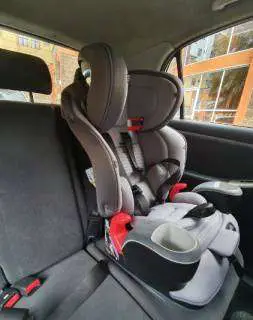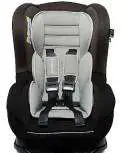This baby car seat guide covers all the big and small things you need to look for when buying a safe riding seat for your child. I bet you’re about to welcome your first baby to the world. Or you’re a mom or dad looking to pick up a forward-facing seat because your baby has outgrown their first rear-facing-only infant car seat. Either way, this buying guide got your back.
But let’s start at the very beginning…
Related: How to Clean a Car Seat
What Is a Baby Car Seat?
A baby car seat is a car seat designed to specific federally regulated safety standards. It’s used by small and not-so-small children who’ve yet to reach the adult seat belt age of 8-12. The District of Columbia and all U.S. states require strict adherence to the regulations each state formulates and enforces. There are three main types of car seats namely rear-facing ONLY seats, forward-facing seats, and booster seats.
Read the comprehensive seat guide below to gain a crystal clear understanding of what each kind is like and how it functions.
There Are Zillions of Car Seat Types
As is the case with most baby gear essentials, the car seat market offers gazillions of different kinds of child safety seats. Infant car seats. Convertible car seats. 3-in-1 seats. 4-in-1 car seats. High-back boosters. Backless boosters. Seat belts. What exactly does your lovely bundle of joy need? Read this guide to learn six different kinds of baby safety car seats.
In this guide, I handhold you as you explore various options for your little angle. Whether they’re a newborn or older, there should be something that’ll suit their transportation needs.
What’s Included in the Deal?
Manufacturers don’t always include every accessory you require to use your seat. Accessories the manufacturer doesn’t include in the purchase are collectively referred to as aftermarket products.
Typically, these are parts the NHTSA doesn’t regulate. That’s why people sometimes describe them as non-regulated aftermarket products. It’s best to use accessories your child car seat’s maker has tested and approved.
What Is a 3-in-1 Car Seat?
The vast majority of moms and dads are pretty familiar with this seat type. Most people want to invest their money in a good-quality car seat that’ll keep their newborn safe while evolving as they grow. For the most part, that option is a 3-in-1 car seat.
With a versatile choice like, you have a seat your child will use for a decade, or until they reach a place in their developmental path where they can use a seat belt without a problem.
A 3-in-1 baby car seat gives your baby three Seating positions:
- A rear-facing position that works well for smaller children including newborns
- A forward-facing Seating position: The best choices come with a 5-point harness
- A seat belt-positioning option known as booster
Rear-facing Position
Most of the choices available allow children to ride rear-facing from infancy to age 2 or older. The majority of 3-in-1s rear-face with a 5-point harness.
Each car seat manufacturer specifies the weight limit a child must reach before transitioning from rear-facing rides to forward-facing positions. Be sure to review the seat maker’s direction on weight limits.
Most safety experts say that children should ride rear-facing for considerably long — as long as possible. If a crash happens during a rear-facing ride, the crash impacts have a larger area of the baby’s body to distribute over.
Forward-facing Rides
When your baby becomes reaches the manufacturer-prescribed rear-facing position weight limit, it’s time to put the top tether and harness to work.
The Booster Option
In most states, children aren’t required to use a car seat past age 8. When your tike hits that age, you’re supposed to have them start using the seat belt. And that’s where the 3-in-1 booster option helps.
The booster feature adds to your kiddo’s height enabling them to comfortably use the seat belt. Be certain that your child is ready for the seat belt before introducing them to it, though.
When that time comes, take off the harness and use the shoulder seat belt and lap belt to secure your child.
Some 3-in-1 Car Seats Are Designed to Last Forever, But…
Do you really want something that’ll last that long? It’s hard to predict how fast your child will grow and how soon they’ll hit recommended weight and height limits. Plus, babies are naturally messy, and their seat covers often degrade quicker than most parents initially imagined.
Besides, car seat technology is always evolving. Wouldn’t it be better to choose something you’ll discard at year 2 and upgrade to something better with superior features?
Infant Only, Booster, and Convertible Safety Seats
You can also use gift your baby a convertible, combination, booster, or forward-facing only car seat. I’ve covered these options in greater detail in this car seat type guide. But below is a brief description for each option in case you don’t want to leave this post now.
1. Infant Only/Rear-facing Only/Infant Car Seats
This option is meant for 5-40lbs tots — generally newborns and toddlers up to age 2 or thereabout. The option offers only one seating position, the rear-facing position. If you buy this, understand you’ll have to upgrade to an all-in-one, 3-in-1, 4-in-1, convertible, or booster seat down the road.
A Rear-facing Seat Needs a Recline Adjuster
An infant-only normally doesn’t let the baby recline fully. The seat always allows a semi-reclined rear-facing seating position. It usually comes with a recline adjuster that lets you keep the seat up or semi-reclined. Another option that relies on a recline adjuster is a convertible seat.
One aspect that makes these seats super attractive is their portability. They use a detachable base that remains attached to your car. That allows you to pick up your baby from their seat without waking them. In that sense, this item works like a soft-structured baby carrier.
Also, some of these seats will click into a grocery cart. But don’t do that — it’s potentially dangerous.
The base eliminates the need to lower attachments (LATCH) or secure the seat belt when putting your baby in or out. This component is where you find the seat angle indicator. There are different seat base designs, but you want one that absorbs impacts in crashes.
What Is a Seat Angle Indicator?
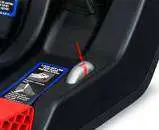
The angle indicator is found somewhere on a rear-facing seat’s base and lets you recline the seat at the correct angle. The right recline angle allows your baby to breathe with ease during rides. This angle indicator is usually an easy-to-read line, dial/wheel, floating bubble, or ball bearing.
Generally, younger babies and newborns use a more reclined setup (usually 45 degrees) because they don’t have enough neck and head control. Older babies can use a more upright recline. Be sure to follow the car seat manufacturer’s recline instructions.
For most low-cost and some pricier seat models, the indicator is a line. Sometimes, this line comes embossed on the detachable base. Other times, the line level indicator sits on a label on the base.
To achieve the right recline angle, use the adjustable foot to raise or lower the seat. This part is typically found on the detachable base of rear-facing seats and a few forward-facing options.
2. Booster Seats (Belt-Positioners)
What is a booster car seat? A booster car seat is a type of regulated baby car seat that increases the child’s height so that the lap belt and shoulder belt can fit them properly. A booster seat doesn’t come with a harness. Booster seats are sold in three options namely:
- Backless boosters
- High-back boosters
- Detachable high-back boosters/hybrid option
If your car lacks headrests, choose the high-back booster. But if your vehicle offers neck and head support, definitely a backless booster. And if you want a two-in-one/hybrid option that you can use in a vehicle with or without headrests, choose a seat with a removable back.
When Should a Kid Start Using a Booster Seat?
When do they outgrow the harness? Most car seat manufacturers advise parents to start using a booster at age 4. But according to the National Highway Safety Administration, parents should continue using a harness until the child outgrows it.
But all kids don’t develop the same. There are lots of 4-year-olds who are not yet ready for the booster no matter what the product description says.
While researching for this baby safety seat guide, I found that children in the 5-7 age range are the perfect candidate for the booster seat.
3. Combination Seats
What is a combination car seat? A combination car seat is a forward-facing ONLY baby safety seat that uses a top tether and a 5-point harness to secure 2-year-olds and older children during rides. To use a combination seat as a booster seat, simply remove the harness and use the adult lap belt and shoulder seat belt.
4. Convertible Seats
What is a convertible baby car seat? A convertible baby car seat is a versatile seat that lets you a rear-facing position initially and a forward-facing position later when the child outgrows the 5-point harness. As soon as the baby reaches the LATCH weight limit, the attachment system (LATCH) MUST be removed. Use the seat belt instead at that point in time.
5. Safety Seat Belt/Adult Seat Belt
What is a car seat belt? A seat belt is a baby safety component that’s designed to restrain young children while riding with adults in a vehicle. This safety device consists of a number of components that make it function as effectively as it usually does. The adult seat belt consists of webbing that works with a buckle, retractor, and latchplate system. This protection system secures your child when they’ve grown big and strong enough to use it.
Latchplate, Retractor, Buckle
A latchplate is the solid part of a seat belt that inserts into the belt’s buckle. Buckles can be on seat belts or on the vehicle’s car seat. Buckles enable you to fasten adult seat belts or to secure harness straps/webbing.
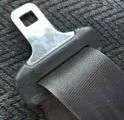
As for the retractor, you can’t see this component, but it’s super important. Without the retractor, you can’t get any extra webbing from your seat belt when you try to roll it up.
In the picture below, the buckle is the component on the left side. The item on the right side is a latchplate.
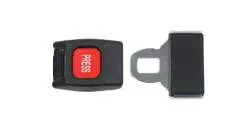
Not all buckles are push buckles, though.
Seat Belt Path
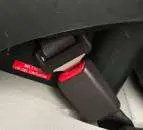
Every car seat features a belt path which is the route the manufacturer designed for the safety belt to pass through or around during use.
Some seats boast one belt path while others such as convertible seats have two or more paths. In a convertible seat, one of the belt paths supports the forward-facing position while the other one is for the rear-facing position.
How to Fit Your Child for the Seat Belt
How do you know that your child is now ready to stop using a booster seat and start using an adult seat belt? The best way to know if they’re ready for the transfer is to perform the simple car seat belt fit tests below.
1. The knee, back, and bottom test: Well, I invented the name. But if your child’s knees bend at the edge of the seat as they sit with their back and bottom against the back of the seat? That’s a clear sign they are ready for the adult seat belt.
2. The lap belt fit test: If your vehicle’s seat belt gives your kiddo a snug fit across their upper thighs or hips, they’re ready for the switch to the adult seat belt.
3. The shoulder belt fit test: When the adult shoulder belt starts fitting across your kid’s chest rather than their belly, they’re big enough for the switch. At that point, the adult safety device also fits snugly across the child’s shoulder rather than across their face or neck.
In truth, these aren’t three tests but one test. You should check all these fit positions at once.
Locking Clip and Lock-Off
Vehicles made after 1996 don’t need the locking clip. The locking clip is an H-shaped metal mechanism that makes it possible to set up a specific length of the seat belt’s webbing. It holds the lap and shoulder straps together so that the webbing doesn’t loosen during use.
As for the lock-off, it’s a built-in feature that functions similar to a locking clip. If your vehicle lacks a locking clip, it certainly must have this modern seat belt-locking mechanism.
By the way, seat belts don’t have a weight limit.
Maybe Your Baby Needs a Car Bed, Not a Car Seat
While preemies can use a car seat, they shouldn’t if they’re too small to fit in there properly. If your baby is too small, you want to stay away from regular car seats and instead use a car bed.
But what is a baby car bed? A car bed is a federally regulated, crash-tested child safety device used while riding with a very small baby (usually a premature baby/preemie). Such children are usually too fragile and weak and lack adequate head and neck control, and the baby normally rides lying flat on the little bed. *Make sure to talk to your pediatrician before putting your preemie on this device.
Does Your Child Need a Special Car Seat?
Kids grow and develop differently. Some kids can’t use regular child safety seats. If that happens to be the case for your little loved one, don’t worry. Because there are specially designed seats for kiddos with special transportation needs.
How to Secure Your Baby’s Car Seat to Your Vehicle
According to Safekids.org, there are two ways to attach a baby car seat to a vehicle. You can either use LATCH or the adult seat belt.
What Is LATCH?
LATCH is an acronym for Lower Anchors and Tethers for Children. LATCH is a three-part seat-attachment system that lets you secure your car seat without needing to use the safety seat belt. Not all vehicles are LATCH-equipped, though.
If your vehicle has a post-2003 manufacturing date, it most likely features the anchors this system needs to work.
To be clear, LATCH works with infant car seats, convertible options, forward-facing only child safety seats. Check your car manual to know if it’s LATCH-supported.
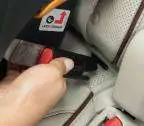
LATCH can seem confusing, but here’s what it is and how it works. This system basically consists of two kinds of straps and anchors where these straps click into. These straps include the top tether and the lower anchor strap. The lower anchors are smallish metal bars that look like the letter U and live to secure/fasten the anchor straps.
Where on the backseat do you install a LATCH-equipped car seat? The majority of parents install their seats in the middle of the backseat. But that’s not always possible if that seat lacks lower anchors (see below section). If that’s the case for your car, the smartest trick is to use the safety belt to secure your seat.
The Lower Anchor Straps and Lower Anchors
At the bottom of the car seat is the lower anchor strap. The lower anchor strap features two buckles or hooks, each buckle/hook on each side of the baby car seat. These buckles clip into the lower anchors.
The lower anchors are found around the crack of the backseat. This crack sits somewhere between the back of the backseat and the seat cushions. The purpose of this strap and its anchor is to support car seat installation.
Top Tether and Top Tether Anchors
And if you check the back of your vehicle’s seat, you should be able to see the top tether. The top tether features a hook or buckle that clips onto the tether anchor. The top tether and its anchor exist to secure forward-facing seats. More specifically, this tether helps prevent head injury to some extent by restricting forward seat movement by between 6 and 8 inches.
Note that the tether anchor isn’t found at the same spot in all cars.
Know Where the Top Tether is Located
According to a Chicago-based certified car seat technician I spoke with, the top tether anchor is typically found somewhere behind the backseat in most sedans.
“It’s pretty easy to find if you cast a glance on the rear shelf,” said Carol, the CPST I talked to while researching for this post. In minivans, SUVs, the top tether anchor is located in different locations and you may have to search for them.
Where to Find the Tether Anchor in SUVs and Minivans
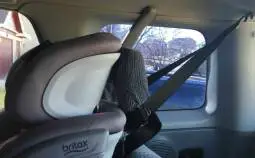
The top tether anchor can be on the SUV’s/minivan’s floor. You may also find it on the vehicle’s ceiling. If you can’t find the anchor in these places, check the cargo area or under the seat.
Sometimes, you’ll find it on the back of the lower or middle of the backseat. And while at it, be sure you’re connecting the tether to the right anchor. It’s not hard to confuse the cargo anchor with the hardware you need to connect to as some parents unknowingly do.
Know Your Seat’s Max LATCH Weight Limit
LATCH systems come with a specific weight limit. Be sure your seat manual and car manual to learn the recommended seat/child weight restriction. Car seats made post-Feb 2015 have a combined maximum child/seat weight restriction of 65lbs. Exceeding that limit can cause the seat to come off the attachment and become a forward-speeding missile!
If all this feels a tad confusing or even overwhelming, don’t worry. Instead, talk to a CPST. There’s one in your community.
Is Your Car Seat Installed Correctly?
Use the Inch Test to check that. It’s a simple, straightforward test that lets you know if you have installed the car seat safely and securely. To know if you did the job right, try moving the installed seat side-to-side or front-to-back. The seat should move a little, but if the shift exceeds 1 inch, you did the installation incorrectly.
What is a Harness?
A harness is basically three or more straps that attach to the vehicle to secure a child. These straps help distribute impact energy to the strongest parts of the body.
Take a look below. That’s how a harness looks like. Once your baby outgrows the harness, you’re to introduce your kiddo to a booster seat.
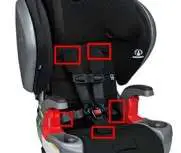
A 5-Point Harness vs a 3-Point Harness
A 5-point harness secures your child through five 5 attachment points. That’s why they call it a 5-point harness. There are 3-point harnesses, too.
But what’s better, a 5-point harness vs. a 3-point harness? Is a 5-point harness safer than a 3-point harness? Generally, a 5-point harness offers greater safety compared to a 3-point one because with a 5-point harness, impact energy spreads over a larger area.
Many parents have observed that it’s harder for children to sit up perfectly in a 3-point harness. In a 5-point harness, a child can fall asleep or make all those shifty movements kids make all the time. This device ensures the kid remains in a more or less upright (optimal) seating position.
5-Point Harness vs. Booster With a 3-Point Seat Belt
What’s safer, a 5-point harness vs. a booster with a 3-point seat belt? It’s hard to say because there’s no definitive scientific evidence (none to my knowledge) that shows one to be superior to the other safety-wise. Each option has certain advantages over the other, but none is a proven better choice.
But it seems to me that restraining an older child (5 and older) in a 5-point harness is better compared to using a booster seat with a 3-point safety belt.
I have watched my kids use both safety systems. And there was never an instance where my harness-restrained child managed to wiggle out of their device. I can’t say the same for the booster seat coupled with a 3-point seat belt.
Here is an interesting 5-point harness vs. booster with a 3-point belt conversation between inquisitive parents. Immerse yourself a bit if you have the time and who knows you might learn something helpful for your situation.
Harness Adjuster, Chest Clip, and Harness Slots
A harness adjuster is a component used for controlling the tightness or looseness of the harness for the perfect fit. You should find this at any one of these places:
- On the harness
- On the back of the baby’s seat
- Between your child’s legs/feet (usually as a push button)
A chest clip makes sure that the harness’ shoulder straps always remain across the chest of the wearer at armpit level. The other name for the chest clip is the harness retainer clip.

As for harness slots, these are actually slots incorporated to keep the harness as close as possible to your child’s shoulders. The more slots, the better. As your baby matures, you’re going to need to rely on a different slot to achieve the right fit.

How to Determine If the Harness is Snug Enough
Perform the so-called Pinch Test to determine if the harness securing your child is snug enough. Buckle the harness, tighten it, and position the chest clip at the same level as the child’s armpit. Then, try pinching the shoulder webbing/strap.
If the webbing is not pinchable because there’s no extra webbing, the harness fits right. If the harness makes marks on the kid’s skin, it’s too tight and that’s not a comfortable fit.
Review Car Seat Labels
Read the labels on your baby’s seat. Because there’s tons of useful information on the labels on how to use the seat correctly. The information on the labels include:
- NHTSA seat safety certification as evidence that the seat meets all required federal Motorvehicle Safety Standards
- The seat’s weight and height limits
- Manufacture date
- Name and address of the manufacturer
- Seat model number
- Airbag warning: Every seat that offers the rear-facing position MUST have the airbag warning label. This label warns you of the potential danger associated with using a rear-facing seat with a vehicle that features a frontal airbag.
- Weight limits for when you must stop using lower anchors and switch to your vehicle’s seat belt
- FAA certification seat use on planes
- Complete and Mail Back that Registration Card
Recalls aren’t rare in the car seat world. A company may recall faulty baby safety seats voluntarily. Or because they’ve been compelled to do so after federal motor vehicle safety standard violations. Check your seat’s labels to review NHTSA’s safety certification.
All seat makers selling in the US market must adhere to specified safety standards when manufacturing and testing seats. Don’t worry. Rest assured that all those seats on sale online and offline are federally approved seats.
Car seat makers are required to repair all defective seats for free or replace them. So, be sure to fill out the seat registration card and mail it back.
Keep Learning, Mom/Dad
Car seats can be pretty confusing, and even the smartest parent can make mistakes. So, keep learning. Once you install your seat, take your vehicle to an inspection station. A certified CPST will check the installation and if anything is amiss, they’ll help correct it.
A certified Child Passenger Safety Technician is a volunteer who likes serving others in their community. A program called Safe Kids Worldwide awards this certification after the volunteer completes the training. The program boasts over 31,000 technicians as of this writing.
Inspections happen at inspection stations including at hospitals, in parking lots, at GM dealerships, and outside stores. They also take place during community activity days. These car seat inspections take place at specific times in one location on specific days. So, make sure to make an appointment with a certified technician.
Wrapping Up
Whoa! That was such a long read. I believe this is one of the most comprehensive car seat guides on the web even if I say it myself. I’m convinced that choosing the right car seat for your brilliant bundle of joy isn’t feeling too overwhelming now.
But if there’s something you think I should have covered but didn’t, please comment below. Thank you for stopping by. I hope you found this resource useful. Safe parenting!
I'm Esther Moni, a proud stay-at-home mom and a psychology graduate of the United States International University (USIU) . I hate it when anyone calls me a housewife, because what does housewife even mean? Being a mother of two babies and a pup, Bailey, as well as being Ricky's wife tires me to no end, but I still manage a smile at the end of it all. And when my boys aren't done doing mischief, I juggle writing a post on parenting or baby gear performance for this blog and running my little counselling office based out in Nairobi. <a href="https://www.facebook.com/esther.moni/">Visit my Facebook profile here</a>, and this is my <a href="https://ke.linkedin.com/in/esther-moni-3841b573/">LinkedIn profile</a>, and here's my <a href="https://www.youtube.com/channel/UCKcVb3NNDrURDH8C0KiAE1g/">nascent youtube channel.
